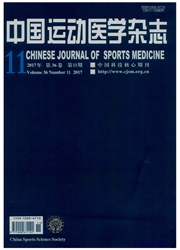

 中文摘要:
中文摘要:
目的:探讨Sprague—Dawley大鼠外周血来源间充质干细胞(mesenchymal stem cells,MSC)的动员、分离培养及鉴定方法,分析其表面标记和多向分化潜能,为运动创伤中的细胞治疗和组织工程产品培育提供新来源的、可以微创获得和自体细胞移植的种子细胞。方法:联合动员大鼠外周血MSC.采集腹主动脉外周血4ml。使用淋巴细胞分离液结合密度梯度离心方法分离外周血单核细胞,体外培养至第3代。于显微镜下观察其形态和生长状态。取第3代MSC,鉴定其表型并向成骨、成脂和成软骨诱导分化.以证明其干细胞的特性。结果:经淋巴分离液结合密度梯度离心方法分离培养的外周血单核细胞.3~5天可见少量长梭形细胞贴壁,7-9天见细胞成簇生长,并形成克隆集落。第3代细胞形态较均一.生长增殖良好;表达典型的MSC标记CD44和CD90,不表达造血干细胞标记CD34和CD45。成骨诱导21天后,茜素红和ALP染色阳性,有矿化结节形成。成脂诱导21天后,油红0染色阳性.细胞内有脂滴形成。细胞微团无血清成软骨诱导21天后。甲苯胺蓝染色阳性,细胞外有蛋白多糖分泌:免疫组织化学染色示,特异性软骨基质II型胶原表达阳性。结论:采用联合药物动员方法能促进干细胞向外周血释放,分离培养的外周血干细胞经鉴定为MSC,体外具备三系分化潜能,有望成为运动创伤中新的细胞治疗和组织工程产品培育的种子细胞来源。
 英文摘要:
英文摘要:
Objective The purpose of this study was to explore the methods of mobilization, isolation, culture and identification of mesenchymal stem cells (MSC) in rat peripheral blood,in order to find a new source for seeding cells with minimally invasion for cell therapy and tissue engineering products culturing in the field of sports traumatology. Methods MSC in peripheral blood were mobilized by ad- ministration of combined drugs. Mononuclear cells in blood samples from the abdominal aorta were iso- lated by lymphocyte separation medium and density gradient centrifugation.then cultured in vitro to the third passage through microscopic observation of morphological characteristics and growth state. The phenotype of the third passage MSC was identified,and the differentiation capacity into bone,adipose and cartilage was confirmed. Results After 3-5 days culture in vitro, a few isolated cells in spindle shape adhered to the plastic walls. And after 7-9 days culture in vitro, cells cluster and colonies appeared. The third passage cells showed uniform morphology and good proliferation with expression of the typical sur- face markers of MSC,including CD44 and CD90,and without expression of surface markers of hematopoietic stem cells such as CD34 and CD45. After 21-day induction of bone formation,the ceils demonstrated positive staining for Alizarin red and ALP, and formation of mineralization nodes. Positive staining for Oil red O and for Tolridine blue,and immunohistochemical staining for type I! collagen con- firmed the formation of cartilage-specific extracellular aggrecans and type II collagen. Conclusion These methods for mobilization by administration of combined drugs could increase the release of stem cells from peripheral blood. MSC cuhured in vitro had eages. MSC derived from peripheral blood could and tissue engineering. multipotent capacity of differentiation along three 1in- be a potential source of seeding ceils for cell therapy
 同期刊论文项目
同期刊论文项目
 同项目期刊论文
同项目期刊论文
 期刊信息
期刊信息
